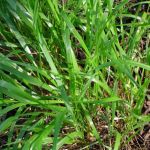| Common Name: |
Spring Grass |
| Other Names: |
Sweet Vernal Grass |
| Botanical Name: |
Anthoxanthum odoratum |
| Genus: |
Anthoxanthum |
| Family: |
Poaceae |
| Location: |
Europe, temperate Asia, Africa |
| Cultivation: |
Well-drained soil in sun. Can become invasive. |
| Propagation: |
By seed sown in spring; by division in autumn or spring. |
| Harvest: |
Flowers are cut as they open and dried for ornament or tinctures. |
| Height: |
18-50cm (7-20in) |
| Width: |
12-30cm (5-12in) |
| Hardiness: |
Z3-9 |
| Parts Used: |
Flowers, Whole Plant |
| Properties: |
An aromatic herb that stimulates the circulation and relieves pain and spasms. |
| Medicinal Uses: |
Internally, and as a nasal lotion, for hay fever. Externally for painful joints, chilblains, nervous exhaustion, and insomnia.
To treat nausea, headaches, insomnia, and urinary tract infections. |
| Typical Dose: |
There is no typical dose of sweet vernal grass. |
| Possible Side Effects: |
Sweet vernal grass's side effects include headache and dizziness. |
| Drug Interactions: |
| Taking sweet vernal grass with these drugs may increase the risk of bleeding or bruising: |
| Abciximab, (ReoPro) |
Antithrombin III, (Thrombate III) |
Argatroban, (Argatroban) |
Aspirin, (Bufferin, Ecotrin) |
| Aspirin and Dipyridamole, (Aggrenox) |
Bivalirudin, (Angiomax) |
Clopidogrel, (Plavix) |
Dalteparin, (Fragmin) |
| Danaparoid, (Orgaran) |
Dipyridamole, (Novo-Dipiradol, Persantine) |
Enoxaparin, (Lovenox) |
Eptifibatide, (Integrillin) |
| Fondaparinux, (Arixtra) |
Heparin, (Hepalean, Hep-Lock) |
Indobufen, (Ibustrin) |
Lepirudin, (Refludan) |
| Ticlopidine, (Alti-Ticlopidine, Ticlid) |
Tinzaparin, (Innohep) |
Tirofiban, (Aggrastat) |
Warfarin, (Coumadin, Jantoven) |
|
| Supplement Interactions: |
Increased risk of bleeding when used with herbs and supplement that might affect platelet aggregation. |
| Culinary Uses: |
Dried leaves can be used for tea. |
| Economic Uses: |
Dried flowers are added to floral arrangements and potpourris. |
| Bibliography: |
Encylopedia of Herbs by Deni Brown Copyright ©: 1995, 2001 Dorling Kindersley Limited pg 124
The Essential Herb-Drug-Vitamin Interaction Guide by Geo. T. Grossberg,MD and Barry Fox,PhD Copyright©2007 Barry Fox,PhD. Pp.448-449 |

